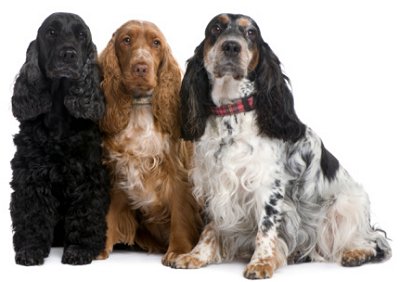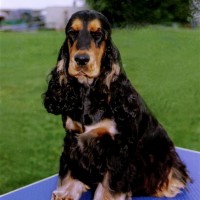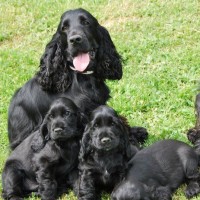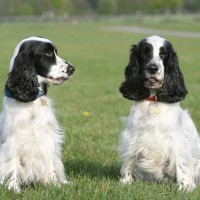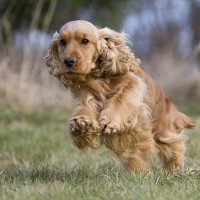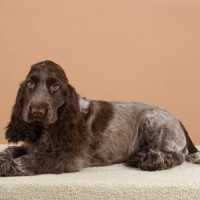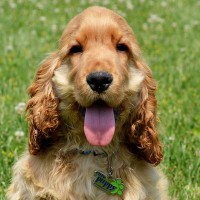Breed information
Group:
Sporting
Life span: 12-14 years
Height male: 38-43 cm/ 15-17 inches
Height female: 36-41 cm/ 14-16 inches
Weight male: 13-16 kg/ 28-34 pounds
Weight female: 12-15 kg/ 26-32 pounds
Character: Affectionate, Faithful, Friendly, Intelligent, Playful, Quiet, Trainable
History
Spaniel type dogs have been found in art and literature for almost 500 years. Initially, spaniels in England were divided among land spaniels and water spaniels. The differentiation among the spaniels that led to the breeds that we see today did not begin until the mid-19th century. During this time, the land spaniels became a bit more specialised and divisions among the types were made based upon weight. According to the 1840 Encyclopedia of Rural Sports, Cockers were 12–20 lb (5.5–9 kg). At this time it was not uncommon for Cockers and Springers to come from the same litter. Even a puppy from a “Toy” sized lineage could grow to be a springer. There is no indication from these early sources that spaniels were used to retrieve game. Rather they were used to drive the game toward the guns.
During the 1850s and 1860s, other types of Cockers were recorded. There were Welsh Springer Spaniels and Devonshire Cockers. Additionally, small dogs from Sussex Spaniel litters were called Cockers. In 1874 the first stud books were published by the newly formed kennel club. Any spaniel under 25 lb (11 kg) was placed in the Cocker breeding pool, however the Welsh Cocker was reclassified as a Springer in 1903 due to its larger size and shorter ear.
The sport of conformation showing began in earnest among spaniels after the Spaniel Club was formed in 1885. When showing, the new Springer and Cocker, both were in the same class until The Spaniel Club created breed standards for each of the types. The Kennel Club separated the two types eight years later. Since then, the Springer and Cocker enthusiasts have bred in the separate traits that they desired. Today, the breed differ in more ways than weight alone.
At Crufts, the English Cocker Spaniel has been the most successful breed in winning Best in Show, winning on a total of seven occasions between 1928 and 2009, with wins in 1930, 1931, 1938, 1939, 1948, 1950 and 1996. In addition, the breed make up three of the four winners who have won the title on more than one occasion with all three coming from H.S. Lloyd's Ware kennel. Due to World War II, the English Cocker Spaniel managed to be the only breed to have won the title between 1938 and 1950, although the competition was only held on four occasions during that period. The most recent best in show was Sh. Ch. Canigou Cambrai in 1996.
Description
The English Cocker Spaniel is an active, merry sporting dog, standing well up at the withers and compactly built. He is alive with energy; his gait is powerful and frictionless, capable both of covering ground effortlessly and penetrating dense cover to flush and retrieve game. His enthusiasm in the field and the incessant action of his tail while at work indicate how much he enjoys the hunting for which he was bred. His head is especially characteristic. He is, above all, a dog of balance, both standing and moving, without exaggeration in any part, the whole worth more than the sum of its parts.
Health
English Cocker Spaniels in UK and USA/Canada have an average lifespan of 11 to 12 years, which is a typical longevity for purebred dogs, but a little less than most other breeds of their size. The English Cocker Spaniel typically lives about a year longer than the smaller American Cocker Spaniel. In a 2004 UK Kennel Club survey, the most common causes of death were cancer (30%), old age (17%), cardiac (9%), and "combinations" (7%). In 1998 and 2002 USA/Canada Health Surveys, the leading causes of death were old age (40%) and cancer (22%). Common health issues with English Cockers are bite problems, skin allergies, shyness, cataracts, deafness (affecting 6.3% of the dogs of this breed), aggression towards other dogs, and benign tumours.
Some uncommon health issues that can also have an effect on English Cocker Spaniels include canine hip dysplasia, patellar lunation, canine dilated cardiomyopathy, and heart murmurs. Hip dysplasia is an abnormal formation of the hip joint which is the most common cause of canine arthritis in the hips. Patellar Lunation, also known as luxating patella, refers to the dislocation of the kneecap. Canine dilated cardiomyopathy is an adult onset condition which occurs when the heart muscle is weak and does not contract properly. It can lead to congestive heart failure, which is where fluid accumulates in the lungs, chest, abdominal cavities, or under the skin. Dilated cardiomyopathy is often accompanied by abnormal heart rhythms, or arrhythmias which can complicate treatment.
Personality
English Cocker Spaniels are happy, easy going animals that make excellent companions for families of all shapes and sizes. Their personalities are more consistent than those of their American Cocker cousins, as puppy mills aren't as attracted to the larger English Cocker Spaniel. They are polite to strangers, tolerant with children and easy to train, making them an excellent choice for first time dog owners and families with kids. They love the company of people, and will be thrilled to accompany family members anywhere they go.
Activity Requirements
Unlike their American counterparts, English Cockers need a good deal of exercise to remain happy and healthy. They are small, but are generally not happy living an apartment or condo lifestyle. Instead, this breed prefers a home with a large fenced-in yard to run in, preferably with a sturdy fence to keep him from chasing birds or small animals into traffic. If possible, Cockers can do well when enrolled in agility and tracking activities. They are not the most intelligent or agile breed and may not steal the show, but they enjoy the activities none the less.
Trainability
Cockers are easy to train, especially when the reward system involves food. This breed is incredibly sensitive and takes it personally when someone treats them harshly, which results in avoidance behaviors, or in some cases, retaliation. Positive reinforcement is always the best road to take when training a Cocker Spaniel.
Best Training Equipment Trainers Recommend
Behavioral Traits
The biggest mistake people make with English Cocker Spaniels is not exercising them enough. When this breed isn't allowed to properly burn off energy, they can develop severe anxiety which results in barking, howling and destructive chewing when left alone. English Cockers crave companionship, and even if properly exercised can still develop severe separation anxiety. For this reason, Cockers are better suited for families with a stay at home parent, or for people who do not work long hours. Barking is a common problem with Cockers, even when they aren't alone. They are alert little watchdogs and will sound the alarm when there is an incoming biker, jogger, car, truck, cat, dog, rabbit or bird. Training them to obey a stop barking command can maintain the sanity of the neighborhood.
Shedding
Owning an English Cocker Spaniel means a lot of maintenance, though they require less than the American Cocker. Many owners opt to clip their Cocker to reduce the need for brushing and maintenance. For those who keep the long hair, brushing the feathers every other day can prevent tangles and matting. Because Cocker Spaniels require regular grooming, it is important to train puppies to be handled by humans at a young age. Cocker Spaniels are prone to ear infections because their long, heavy ears do not allow for air to circulate into the ear canal. Veterinarians can recommend a cleanser that can be used on a regular basis to keep the ears dry and free from wax and bacteria. It is important to brush a Cocker Spaniel's teeth on a regular basis to prevent tartar buildup and promote healthy gums.
